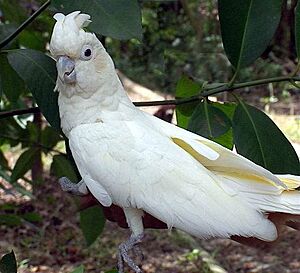Red-vented cockatoo facts for kids
Quick facts for kids Red-vented cockatoo |
|
|---|---|
 |
|
| In Palawan, Philippines | |
| Conservation status | |
| Scientific classification |
The red-vented cockatoo is a special kind of bird found only in the Philippines. It is also known as the Philippine cockatoo or by local names like katala. This beautiful bird is a type of cockatoo, which is a kind of parrot.
You can easily spot this cockatoo because of the bright red feathers under its tail. It looks a bit like another bird called the Tanimbar corella, but the red feathers make it unique. Sadly, the red-vented cockatoo is in danger. Its home is disappearing, and many are caught illegally to be sold as pets.
Contents
What Does the Red-vented Cockatoo Look Like?
The red-vented cockatoo has mostly white feathers. It has a patch of red feathers under its tail, which have white tips. The feathers under its tail and wings are a light yellow color.
This bird is about 12 inches (30 cm) long. Its wings can spread out to about 8.6-inch (22 cm) wide. It has a light-colored beak and white skin around its eyes. Its crest, which is a group of feathers on its head, is usually flat.
Sounds and Diet
The red-vented cockatoo makes a special bleating sound. It also makes screeching or whistling noises, like many other cockatoos. However, it is usually quieter than some other types of cockatoos.
These birds mostly eat seeds. They also enjoy fruits, flowers, and nectar. Sometimes, they eat rice and corn from farms. Because of this, farmers sometimes see them as pests.
Where Do Red-vented Cockatoos Live?
Red-vented cockatoos live in lowland forests, usually below 50 meters (about 164 feet) above sea level. They prefer areas near rivers or coasts, especially where there are mangrove trees.
Why Are They in Danger?
The red-vented cockatoo is listed as critically endangered. This means it is very close to disappearing forever. Experts believe there are only about 430 to 750 adult birds left in the wild.
In the past, these cockatoos lived on many islands in the Philippines. But their numbers have dropped a lot. Today, you can mostly find them on islands like Palawan, Tawitawi, Mindanao, and Masbate.
Helping the Cockatoos
A group called the Katala Foundation has been working hard since 1998 to protect these birds. They have a special program on Rasa Island in Palawan. Thanks to their efforts, the number of cockatoos in some areas has grown. For example, on Rasa Island, the population increased from 23 birds in 1998 to 260-340 by 2015.
However, many threats still exist. People illegally trap these birds to sell them as pets. A single bird can be sold for a lot of money. Their homes are also being destroyed by illegal logging, farming, mining, and new buildings.
Climate change is also a problem. On Rasa Island, dry weather has caused many baby birds to die in their nests. Despite all the efforts, the total number of red-vented cockatoos is still going down in many places.
Organizations like the Katala Foundation are trying to move some birds to new, safe places. They are also working to stop plans for a coal power plant on Palawan's coast, which would harm the cockatoo's habitat.
See also
- Katala Foundation, Inc.




